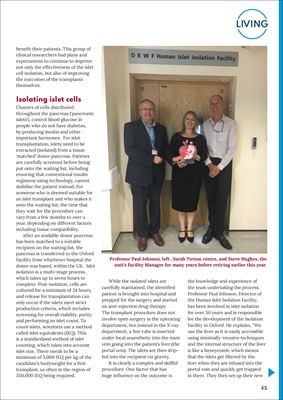
25
LIVING
benefit their patients. This group of
clinical researchers had plans and
expectations to continue to improve
not only the effectiveness of the islet
cell isolation, but also of improving
the outcomes of the transplants
themselves.
Isolating islet cells
Clusters of cells distributed
throughout the pancreas ('pancreatic
islets'), control blood glucose in
people who do not have diabetes,
by producing insulin and other
important hormones. For islet
transplantation, islets need to be
extracted (isolated) from a tissue
'matched' donor pancreas. Patients
are carefully screened before being
put onto the waiting list, including
ensuring that conventional insulin
regimens using technology, cannot
stabilise the patient instead. For
someone who is deemed suitable for
an islet transplant and who makes it
onto the waiting list, the time that
they wait for the procedure can
vary from a few months to over a
year, depending on different factors
including tissue compatibility.
After an available donor pancreas
has been matched to a suitable
recipient on the waiting list, the
pancreas is transferred to the Oxford
Facility from whichever hospital the
donor was based, within the UK. Islet
isolation is a multi-stage process,
which takes up to seven hours to
complete. Post-isolation, cells are
cultured for a minimum of 24 hours,
and release for transplantation can
only occur if the islets meet strict
production criteria, which includes
screening for overall viability, purity
and performing an islet count. To
count islets, scientists use a method
called islet equivalents (IEQ). This
is a standardised method of islet
counting, which takes into account
islet size. There needs to be a
minimum of 5,000 IEQ per kg of the
candidate's bodyweight for a first
transplant, so often in the region of
350,000 IEQ being required.
Professor Paul Johnson, left , Sarah Tutton centre, and Steve Hughes, the
unit's Facility Manager for many years before retiring earlier this year.
While the isolated islets are
carefully maintained, the identified
patient is brought into hospital and
prepped for the surgery and started
on anti-rejection drug therapy.
The transplant procedure does not
involve open surgery in the operating
department, but instead in the X-ray
department, a fine tube is inserted
under local anaesthetic into the main
vein going into the patient's liver (the
portal vein). The islets are then dripfed
into the recipient via gravity.
It is clearly a complex and skillful
procedure. One factor that has
huge influence on the outcome is
the knowledge and experience of
the team undertaking the process.
Professor Paul Johnson, Director of
the Human Islet Isolation Facility,
has been involved in islet isolation
for over 30 years and is responsible
for the development of the Isolation
Facility in Oxford. He explains, "We
use the liver as it is easily accessible
using minimally-invasive techniques
and the internal structure of the liver
is like a honeycomb, which means
that the islets get filtered by the
liver when they are infused into the
portal vein and quickly get trapped
in there. They then set up their new